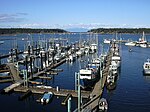HMCS Saskatchewan (DDE 262)
1961 shipsCold War destroyers of CanadaMackenzie-class destroyersPortal templates with redlinked portalsShipwrecks of the British Columbia coast ... and 1 more
Use Canadian English from January 2023
HMCS Saskatchewan was a Mackenzie-class destroyer that served in the Royal Canadian Navy (RCN) and later the Canadian Forces. She was the second Canadian naval unit to bear the name HMCS Saskatchewan. The ship was named for the Saskatchewan River which runs from Saskatchewan to Manitoba in Canada. Entering service in 1963, she was mainly used as a training ship on the west coast. She was decommissioned in 1994 and sold for use as an artificial reef. She was sunk as such in June 1997 off British Columbia.
Excerpt from the Wikipedia article HMCS Saskatchewan (DDE 262) (License: CC BY-SA 3.0, Authors).HMCS Saskatchewan (DDE 262)
Area E (Nanoose Bay)
Geographical coordinates (GPS) Address Nearby Places Show on map
Geographical coordinates (GPS)
| Latitude | Longitude |
|---|---|
| N 49.216 ° | E -123.8845 ° |
Address
Area E (Nanoose Bay)
Area E (Nanoose Bay)
British Columbia, Canada
Open on Google Maps









